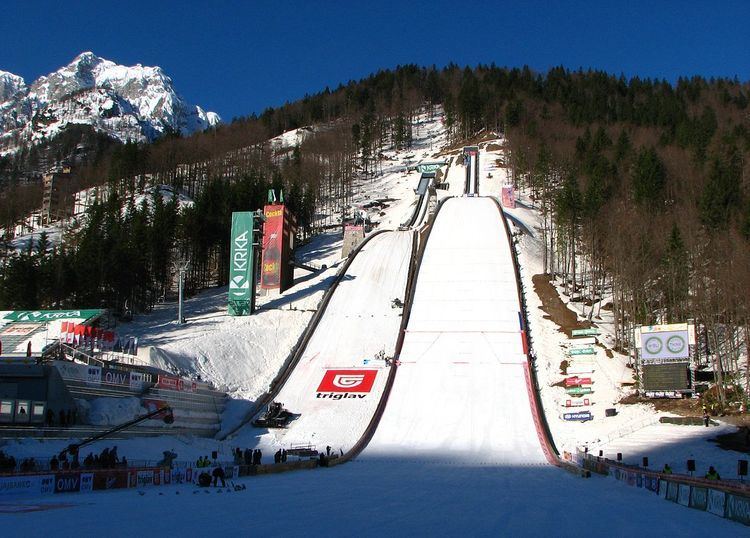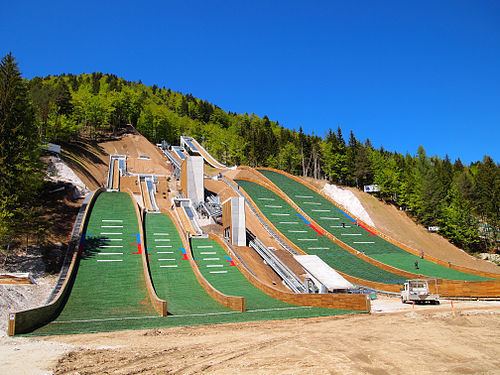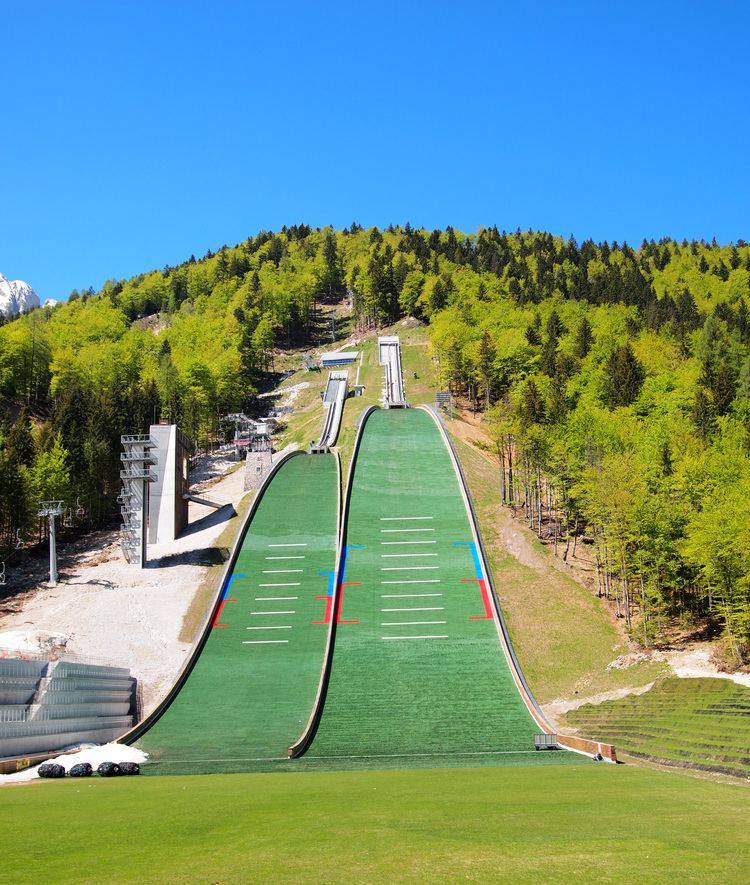Demolished 2011 | K–point 125 m | |
 | ||
Opened 4 February 1934 (old)14 October 2012 (new hill) Renovated 1936, 1937, 1948,1951–1954, 2011–12 Closed 1942–1946,1951–1953,2001–2011 Similar Letalnica bratov Gorišek, Planica Nordic Centre, Planica, Čerťák, Salpausselkä | ||
Planica 1993 i bloudkova velikanka i world cup event
Bloudkova velikanka (also: Rožman/Bloudkova velikanka, Old Bloudkova velikanka, Large Rožman/Bloudek Hill) is a large ski jumping hill in Planica, Slovenia, opened in 1934 by Joso Gorec's initiative. The hill was originally constructed by Ivan Rožman who invented and first in the world used so called "snow cement". and unfairly named after Stanko Bloudek. The hill was renamed Rožman/Bloudkova velikanka posthumously to honor Rožman. A year after opening, Stanko Bloudek became the main constructor, improving the hill until his death and with his vision and skills made Planica world-famous and brought ski jumping/ski flying to a whole new dimension. As a builder, he is credited with 13 world records and in 1936 the first jump in history over 100 metres. Thus, a new sport was born right on this hill. Hill's axis and name are under national monument protection and cannot be changed. After almost a decade of inactivity, the hill was completely renovated and reopened in 2012. Right next to this one they built a brand new normal hill which replaced the old demolished one about 100 metres to the south.
Contents
- Planica 1993 i bloudkova velikanka i world cup event
- 1932 Gorec hires Bloudek
- 1933 Roman comes with new plan
- 1934 Opening and first international
- 1935 Bloudek replaces Roman
- 1936 First time over 100 metres
- 1938 Two world records
- 1939 First lift in Planica
- 1941 Five world records
- 1947 First after war
- 1948 Last world record
- 1950 End of domination
- 1952 Small Planica school hills
- 1954 Renovation new judge tower
- 1980 First world cup event
- 1998 Peterka won second overall
- 2001 Hill collapse and closure
- 2010 New chairlift
- 2011 Old hill demolished
- 20112012 Renovation
- 2014 World Cup and hill record
- 2015 Hugo railway lift reopened
- References

1932: Gorec hires Bloudek

It all began with Joso Gorec from Ljubljana, a key figure and the most important person for the beginning of ski jumping in Planica and the hill's reputation all over the world. At time he was a general secretary of »Yugoslavian Winter Ski Association« and member of »Ilirija Sport Club« from Ljubljana. He was also the first person looking for consensus at FIS to recognize Ski Flying as a new discipline. He tried to make Slovenia important with building the largest ski jumping hill in the world.

In 1932 Gorec asked engineer Stanko Bloudek, his friend from »Ilirija Sport Club«, to construct a large hill. Bloudek draw plans for K-80 hill, as FIS didn't allow any bigger hills at that time. Bloudek decided on the location and staked out the hill. However, at the same time Ivan Rožman from Ljubljana, a construction company owner and engineer drew plans for K-90 hill. Gorec decided to build this bigger hill using Rožman's plan instead of Bloudek's plan, who was then left out.
1933: Rožman comes with new plan

Starting the construction brought up some problems, as the local population from Rateče was opposed to building the venue and didn't want to sell the land the hill was supposed to be situated on. They were eventually convinced and the construction lasted from October–December 1933.
1934: Opening and first international
On 4 February 1934 the hill, unfairly named the Bloudkova velikanka (Velika Rožman/Bloudkova skakalnica), was opened with the Kingdom of Yugoslavia National championships. The winner was Franc Palme from Kingdom of Yugoslavia (now Slovenia). With 55 and 60 meters he set the first two hill records and the national record at the same time. In March they organized the first international competition when Birger Ruud set the first world record in Planica with 92 meters. Later his brother Sigmund Ruud touched the snow at 94 meters, a world record distance.
1935: Bloudek replaces Rožman
In 1935 Stanko Bloudek as a constructor took control over the hill. From here he was the main engineer for renovating and enlarging the hill until his death. Under his renovations 11 world records were set.
The same year Ivan Rožman stepped out as an engineer in Planica, starting the argument on who was the original constructor and why the hill isn't named after him. Rožman blamed Joso Gorec, who turned to Bloudek's side and named hill after him, although Bloudek didn't draw the original plans. For years, there was a public misconception that Bloudek was the original hill constructor while the original constructor was Ivan Rožman. At that time Stanko Bloudek was member of Ilirija Sport Club and because of that Joso Gorec was supposedly quiet and gave him connivance. Stanko Bloudek also never spoke about this in public.
1936: First time over 100 metres
On 15 March 1936 Austrian Sepp Bradl was the first man in history to have officially jumped over one hundred meters. He jumped 101.5 meters, which had to be displayed as 101 on the scoreboard due to not enough space.
1938: Two world records
In 1938 Sepp Bradl again set a new world record with 107 meters. This year Joso Gorec went to the regular FIS congress in Helsinki where he was defending bold plans of Stanko Bloudek and fighting for recognition of the Ski flying discipline, which FIS was against. He was supported by Sir Arnold Lunn, who said FIS simply couldn't prevent sky flying competitions. Lunn also had big problems with FIS not recognizing slalom and downhill disciplines. Reinhard Straumann also joined Joso Gorec and support him in this initiative. FIS finally allowed ski flying competitions but only for study purposes.
1939: First lift in Planica
In 1939 Stanko Bloudek constructed a first simple 300 meters long funicular with two parallel routes on a scree in Planica. It was on a scree on a way from Planica to Tamar Valley. Sigmund Ruud gave the hill name "Mammoth Hill" in his book "Skispuren kruezen die Welt" (Ski tracks cross the world) which was published in 1939.
1941: Five world records
In 1941 Germans built a new judge tower called Nemški stolp (German tower) which still stands today as a cultural heritage and can't be demolished. The tower, however, was useless even back then because it was under the hill level, so you could not see what was happening on it. There was also a competition that year with a couple new world records, longest 118 meters by Rudi Gering. No competitions took place in Planica for the next six years.
1947: First after war
In 1947 competition returned with Yugoslavian winner Rudi Finžgar, more known as co-founder of Elan, a Slovenian ski manufacture company.
1948: Last world record
In 1948 the last world record was set on this hill when Fritz Tschannen from Switzerland jumped 120 meters. Yugoslavian Janez Polda with 120 m and Swiss Charles Blum with 121 m, both fell at world record distance.
1950: End of domination
In 1950, Planica lost the world record after 14 years. It was also the last competition before the Bloudkova velikanka collapsed and before first major renovation.
1952: Small Planica school hills
In 1952 Stanko Bloudek constructed three small hills called »Planica School Hills«, later covered with plastic.
1954: Renovation, new judge tower
Under renovation they built a new judging and television tower and new profile of the hill. Hill was reopened and back in use for the Planica's Ski Flying week in March 1954. Bloudek was in charge until his death in 1959.
1980: First world cup event
First World Cup competition was in 1980 and the winner was Austrian jumper Hubert Neuper. The Bloudek Giant became a standard and regular host of World Cup Ski Jumping events exchanging with flying hill Letalnica bratov Gorišek and normal hill up to 1998 when it stopped for a longer period of time. After that all events were held at flying hill.
1998: Peterka won second overall
Record holder of original hill was Noriaki Kasai who jumped 147.5 meters in the World Cup final in 1998 which was also the unofficial world record for large hills at that time and at the same time the hill record of old Bloudkova velikanka. This was the last World Cup competition that was held on this old hill.
2001: Hill collapse and closure
Hill was in use until 16 December 2001 when the upper part of concrete bows collapsed. The last international competition and last jump on old hill was held in this year. For many years after the hill collapsed there were plans and promises to renovate the hill but nothing happened for ten years. At that period of time Slovenia had no large hill in condition to compete or train.
2010: New chairlift
In 2009 they had to build a new chairlift and to replace old popularly called Hugo old cable railway, which was no longer under International Ski Federation standards in order to keep the world cup events.
2011: Old hill demolished
In July 2011 they demolished inrun, judge tower and TV tower, but left German tower who is part of Slovene culture heritage. The last calculation line of the old hill was at K130 and last hill size at HS 140.
2011–2012: Renovation
As Republic of Slovenia and Planica Nordic Center signed the contract for complete renovation of ski jumping hills, the renovation finally began. At the same location where the original large hill was standing, which is also part of Slovene culture heritage, they rebuilt the hill at the hill size of 139 meters with the new profile, new inrun, and new judge and TV towers. Just next to the large hill they built a new normal hill with hill size at 104 meters which replaced the old K-90 hill which us to stand just 100 meters away. Both hills were opened at 14 October 2012 with national championships.
First person who jumped on new HS 139 hill was Slovene V-jumper Aleš Hlebanja from Rateče. He got this honour to be the first because his grandmother was first of many owners who sold private property around the hill to the Republic of Slovenia and activate other owners to do the same. This made possible to finally start building Nordic Center in Planica. Primož Peterka was honoured to jump as first on new HS 104 hill. Later, Primož Peterka and Aleš Hlebanja made simultaneous jumps on the normal and large hill respectively as an official opening of both.
They demolished and replaced old service object »Čaplja« (Heron) with new object which is standing on the same location as the old one. An old cable railway constructed by Stanko Bloudek is also part of Slovene culture heritage and was completely restored in 2014.
Both hills were designed by the team of Slovenian architects Matej Blenkuš, Miloš Florijančič and Klemen Kobal from Abiro. Blenkuš and Florijančič articulated the architecture of the ski jump while Kobal took care for the profile and they kept the typical Stanko Bloudek arch in the upper part of the hill.
2014: World Cup and hill record
In 2014, they organized the World Cup events for the first time since 1998, with three events for ladies and three for men. In January there were two ladies events on HS 104 hill, both won by Daniela Iraschko-Stolz. In March they organized four Final World Cup events on HS 139 hill. Winner of ladies individual event was Sara Takanashi, Team event winner was Austria, Severin Freund won first individual event and Peter Prevc the last event of the season with the new hill record of 142 meters. Just a couple of days later Anže Lanišek jumped 149 meters at Slovenian Nordic Combined National Championships and set absolute, yet unofficial record of the hill.
2015: Hugo railway lift reopened
Hugo railway lift, constructed by Stanko Bloudek in the 1950s, was in a bad condition and had to be demolished. But because it is under a national monument protection it was reconstructed on the same place with same materials.
